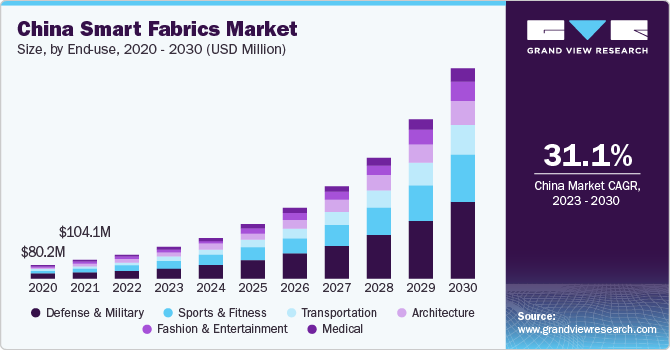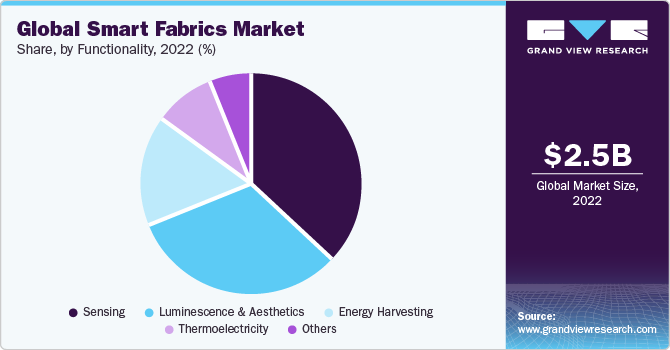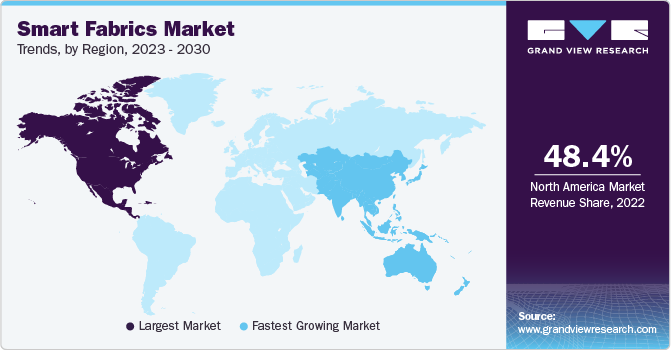- Home
- »
- Next Generation Technologies
- »
-
Smart Fabrics Market Size, Share & Growth Report, 2030GVR Report cover
![Smart Fabrics Market Size, Share & Trends Report]()
Smart Fabrics Market Size, Share & Trends Analysis Report By Product (Passive, Active, Very Smart), By Functionality (Sensing, Energy Harvesting, Luminescence & Aesthetics), By End-use, By Region, And Segment Forecasts, 2023 - 2030
- Report ID: 978-1-68038-061-3
- Number of Report Pages: 125
- Format: PDF, Horizon Databook
- Historical Range: 2017 - 2021
- Forecast Period: 2023 - 2030
- Industry: Technology
Smart Fabrics Market Size & Trends
The global smart fabrics market size was valued at USD 2.48 billion in 2022 and is anticipated to grow at a compound annual growth rate (CAGR) of 31.3% from 2023 to 2030. This growth is driven by factors such as increasing demand for wearable technology, advancement in textile manufacturing, expanding industrial & military applications, and rising traction in healthcare applications. Smart textiles/fabrics are advanced fabrics developed with novel technologies that offer the wearer added value. Some fabrics also accumulate energy from the surroundings by extracting vibrations, heat, or sound, responding to these inputs. Such textiles are used across several applications to enhance performance and add aesthetic value. For instance, in July 2021, Nextiles, Inc. launched a smart fabric software development kit (SDK), which uses smart fabric to record human movement data. It develops smart fabrics with biomechanic and biometric sensing capabilities by fusing conventional sewing methods with printed circuit boards.

Until now, most smart fabrics have been limited to niche usage, including the high-end fashion, military & defense, and medical sectors. However, now the industry is witnessing a shift with a positive confluence of technology and textiles that have led to the easy integration of comfortable fabric-based sensors together with the advent of conductive yarns that can be woven into fabrics. Smart textiles are also anticipated to revolutionize the smart wearables market.
Developing clothes/fabrics that monitor every movement with groundbreaking technology, which allows the recycling and reuse of textiles, is expected to play a key role in driving the market over the forecast period. Technological advancements in the wireless and electronics segment have led to the miniaturization and assimilation of electronic components in conductive textiles, thereby spurring market growth. The rise in the Bluetooth Low Energy (BLE) technology integration that offers features such as low power consumption and multi-vendor interoperability will also contribute to the growth.
Attires enabled with BLE technology can feel, sense, and regulate data, provided the device has an internet connection. The increasing popularity of sophisticated gadgets with various technologically advanced functions, including sensing and reacting to the surroundings, is expected to drive the market. Components, such as actuators, controllers, and sensor units, are incorporated into these fabrics for proper functioning. For protection and safety, consumers & military professionals use smart textiles/fabrics as a clothing entity.
Furthermore, decreasing the manufacturing costs of electronic components is expected to fuel the market over the forecast period. A rise in demand can also be attributed to the introduction of conductive materials and advanced fibers used to manufacture such fibers. Nanotechnology has helped in the creation of such intelligent fabrics at a microscopic level and also in the development of army uniforms and equipment.
The COVID-19 pandemic had a significant negative impact on the smart fabrics market. Restrictions on international trade, factory closures, and limitations on transportation have caused delays in the supply of raw materials and finished products. The economic uncertainties resulting from the pandemic have led to reduced consumer spending on non-essential items, including smart fabrics. On the other hand, the pandemic has also created new opportunities for smart fabrics in healthcare and hygiene-related applications. The demand for antimicrobial and self-cleaning fabrics, as well as wearable health monitoring devices has increased. Smart fabrics that offer features like virus filtration and temperature monitoring have gained attention in the healthcare sector.
Functionality Insights
Based on functionality, the global market has been segmented into sensing, energy harvesting, luminescence & aesthetics, thermoelectricity, and others. The sensing segment accounted for the largest market share of 37.3% in 2022. It is attributed to the ability to sense, which is the most essential attribute of any smart garment. These fabrics are embedded with sensors that can detect and measure various physical attributes such as temperature, pressure, moisture, and movement. They are used in sports and fitness monitoring, healthcare, and military applications.

On the other hand, the energy harvesting segment is projected to register the fastest CAGR of 32.0% over the forecast period. These fabrics are designed to capture and store energy from the surrounding environment, such as solar or kinetic energy. The stored energy can power electronic devices or sensors integrated into the fabric.
Regional Insights
North America dominated the market and held the largest share of 48.4% in 2022 and is also projected to be the fastest-growing regional market. North America is home to several prominent companies operating in the smart fabric industry. These companies are developing, manufacturing, and marketing smart fabric-based products, contributing to the market's growth. The presence of established players helps drive product innovation and market competitiveness. The region has a robust technological infrastructure and expertise, facilitating advancements in smart fabric technologies.

Asia Pacific is also anticipated to witness steady growth during the forecast period. The availability of low-cost raw materials and labor in Asian countries, such as China, Japan, and India, has transformed it into a manufacturing hub for such technology. It has led to a decline in the European region's overall production of smart fabrics. However, an increasing number of R&D activities for such intelligent fabrics sponsored within the EU FP6 and FP7 programs are revitalizing the industry in European countries.
Product Insights
The active segment held the largest market share of 42.8% in 2022. The active segment includes sports and fitness activities fabrics, such as workout clothes, sports bras, fitness bands, and running shoes. Smart fabrics offer several advantages in this segment, including enhanced performance, comfort, and monitoring capabilities. Smart fabrics in the active arena often incorporate technologies like moisture-wicking, temperature regulation, and compression. These features help improve athletic performance by keeping the wearer dry, cool, and comfortable during workouts. Smart fabrics can also enhance flexibility and movement, providing a better range of motion.
The very smart product segment is expected to expand at the fastest CAGR of 37.7% over the forecast period. It is attributed to continuous advancement in sensor technology, conductive material, and miniaturization of electronic components attached to smart fabrics.
Passive smart fabrics are wearable clothing that can sense the user's movement and environment. The segment is expected to expand significantly during the forecast period due to low product prices and less complex functionalities than other variants. The very smart textile can sense, react, and adapt its behavior to the given circumstances and follows the Artificial Intelligence (AI) principle. Also, its ability to effectively deal with life-threatening circumstances, such as accidents or to maintain high levels of comfort even during extreme environmental changes is anticipated to fuel its growth.
End-use Insights
Based on end-use, the defense & military segment accounted for the largest revenue share of 28.2% in 2022. The defense & military sectors are exploring the use smart fabrics for applications such as soldier protection systems, body monitoring, and communication. Smart fabrics' lightweight and flexible nature makes them suitable for these industries, where mobility and comfort are crucial. Integrating these products with electronic products offers a lightweight option against heavy batteries integrated with garments used in defense & military. Warrior systems are anticipated to be equipped with wireless weapons, chemical and biological threat detectors, heads-up displays, global positioning systems (GPS), and battery power for enhanced safety.
The sports & fitness segment is anticipated to expand substantially over the forecast period. Smart textiles can react to mechanical, thermal, magnetic, chemical, and electrical stimuli. Due to these abilities, it can be used in sophisticated electronic devices, including fitness watches and belts, for monitoring health and body vitals in real-time. Smart fabrics are also used in medical applications to reduce recovery time. The rising global population has created a demand for improved healthcare and medical facilities, contributing to market growth.
Key Companies & Market Share Insights
The key players are involved in new product developments, research & development, product launches, mergers and acquisitions, and expansion strategies to enhance their market penetration. For instance, in July 2022, MIT researchers invented smart fabrics that closely fit the body and can detect the wearer's posture and movements using a revolutionary production method. The researchers could also significantly increase the accuracy of pressure sensors woven into multilayered knit textiles, which they refer to as 3DKnITS, by utilizing a specific kind of plastic yarn and a thermoforming technique to melt it partially.
Key Smart Fabrics Companies:
- Adidas AG
- AiQ Smart Clothing Inc.
- Clothing+ (Jabil Circuit, Inc.)
- EXO2
- Gentherm, Inc.
- Mide Technology Corporation
- Nike, Inc.
- Ohmatex ApS
- Sensing Tex SL
- Thermosoft International Corporation
Recent Developments
-
In April 2023, researchers in the UK achieved a significant development by producing the world's inaugural smart fabric capable of transforming its shape and color in response to two distinct stimuli: heat and electricity. This breakthrough development unlocks many possibilities in numerous domains, including virtual reality and robotics. The fabric comprises stimuli-responsive materials (SRMs) that react to external stimuli such as light, temperature, magnetic fields, or electricity. When exposed to these stimuli, the SRM undergoes molecular composition, mechanical properties, or shape alterations. This advancement paves the way for innovative applications and advancements in responsive textiles.
-
In April 2023, researchers at the University of Waterloo created a groundbreaking smart material capable of responding to two distinct stimuli: heat and electricity. This remarkable development marks the first-ever material with such dual responsiveness. This smart material's innovative design opens up many possibilities for various applications. For instance, it could be utilized in clothing that generates warmth as one walks from the car to the office during winter. Additionally, it could be employed in vehicle bumpers that regain their original shape following a collision. These examples demonstrate the broad potential of this unique material in enhancing everyday experiences and advancing technology.
-
In February 2023, a collaborative effort between researchers at Finland's Aalto University and the University of Cambridge resulted in the development of innovative textiles capable of changing their shape in response to temperature variations. These responsive smart fabrics offer customizable aesthetics and hold the potential for monitoring people's health, improving thermal insulation, and providing tools for controlling room acoustics and design.
-
In July 2022, Adidas introduced its inaugural collaboration with Spinnova by launching a new product. The Adidas TERREX HS represents the first knitted item that incorporates Spinnova technology. This mid-layer hiking hoodie employs a fabric composition consisting of at least 30% wood-based SPINNOVA fibers (alongside other fibers) and 70% organic cotton. The SPINNOVA fibers are derived from wood pulp, ground with water into a paste, and spun into textile fibers. This collaboration marks Adidas' foray into utilizing sustainable materials and advancing innovative manufacturing processes in their product offerings.
-
In May 2021, Microsoft developed and implemented Brookdale, a prototyping system for wearable technology. This system introduces plug-and-play hardware and user-friendly drag-and-drop software, empowering fashion designers to program and incorporate new technologies into their creations, thus bridging the gap between fashion and technology.
Smart Fabrics Market Report Scope
Report Attribute
Details
Market size value in 2023
USD 3.24 billion
Revenue forecast in 2030
USD 21.85 billion
Growth rate
CAGR of 31.3% from 2023 to 2030
Base year for estimation
2022
Historical data
2017 - 2021
Forecast period
2023 - 2030
Report updated
November 2023
Quantitative units
Revenue in USD million/billion and CAGR from 2023 to 2030
Report coverage
Revenue forecast, company ranking, competitive landscape, growth factors, and trends
Segments covered
Product, end-use, functionality, region
Regional scope
North America; Europe; Asia Pacific; Latin America; MEA
Country scope
U.S.; Canada; U.K.; Germany; France; China; India; Japan; South Korea; Australia; Brazil; Mexico; United Arab Emirates; Saudi Arabia; South Africa
Key companies profiled
Adidas AG; AiQ Smart Clothing Inc.; Clothing+ (Jabil Circuit, Inc.); EXO2, Gentherm, Inc.;Mide Technology Corporation; Nike, Inc.; Ohmatex ApS; Sensing Tex SL; Thermosoft International Corporation
Customization scope
Free report customization (equivalent to up to 8 analyst’s working days) with purchase. Addition or alteration to country, regional & segment scope
Pricing and purchase options
Avail customized purchase options to meet your exact research needs. Explore purchase options
Global Smart Fabrics Market Report Segmentation
This report forecasts global, regional, and country revenue growth and analyzes the latest industry trends in each sub-segments from 2017 to 2030. For this study, Grand View Research has segmented the global smart fabrics market report based on product, end-use, functionality, and region:

-
Product Outlook (Revenue, USD Million, 2017 - 2030)
-
Passive
-
Active
-
Very Smart
-
-
End-use Outlook (Revenue, USD Million, 2017 - 2030)
-
Fashion & Entertainment
-
Sports & Fitness
-
Medical
-
Transportation
-
Defense & Military
-
Architecture
-
-
Functionality Outlook (Revenue, USD Million, 2017 - 2030)
-
Sensing
-
Energy Harvesting
-
Luminescence & Aesthetics
-
Thermoelectricity
-
Others
-
-
Regional Outlook (Revenue, USD Million, 2017 - 2030)
-
North America
-
U.S.
-
Canada
-
-
Europe
-
U.K.
-
Germany
-
France
-
-
Asia Pacific
-
China
-
Japan
-
India
-
Australia
-
South Korea
-
-
Latin America
-
Brazil
-
Mexico
-
-
Middle East and Africa
-
United Arab Emirates (UAE)
-
Saudi Arabia
-
South Africa
-
-
Frequently Asked Questions About This Report
b. The global smart fabrics market size was estimated at USD 2.48 billion in 2022 and is expected to reach USD 3.24 million in 2023. .
b. The global smart fabrics market is expected to grow at a compound annual growth rate of 31.3% from 2023 to 2030 to reach USD 21.85 million by 2030.
b. North America dominated the smart fabrics market with a share of 48.4% in 2022. This is attributable to the increasing demand from the transportation and healthcare industries in the region.
b. Some key players operating in the smart fabrics market include Adidas AG O’Neil, Nike Inc., Auxetix, Eleksen, Fibretronic Limited, Clothing+, Exo2,ThermoSoft International, Gentherm, and Peratech Ltd.
b. Key factors that are driving the market growth include the development of clothes/fabrics that monitor every movement with groundbreaking technology, technological advancements in electronics, rise in the integration of the Bluetooth Low Energy (BLE) technology, and decreasing manufacturing costs of electronic components.
Share this report with your colleague or friend.
![gvr icn]()
NEED A CUSTOM REPORT?
We can customize every report - free of charge - including purchasing stand-alone sections or country-level reports, as well as offer affordable discounts for start-ups & universities. Contact us now
![Certified Icon]()
We are GDPR and CCPA compliant! Your transaction & personal information is safe and secure. For more details, please read our privacy policy.
We are committed towards customer satisfaction, and quality service.
"The quality of research they have done for us has been excellent."





